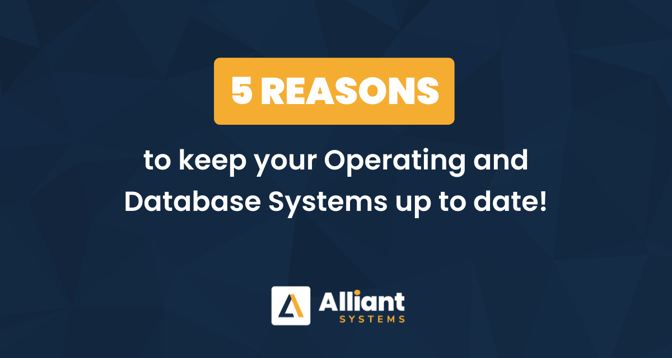Share this
The Importance of Keeping Your Operating and Database Systems Up to Date
by Eric Smith on Jun 20, 2023 8:06:04 AM
In the fast-paced world of technology, it is crucial for businesses to prioritize the regular updating and upgrading of their operating and database systems. In this blog post, we will explore five compelling reasons why businesses should prioritize the maintenance of their operating and database systems from both a business and security perspective.
1. Enhanced Security:
Maintaining up-to-date operating and database systems is paramount for bolstering your organization's security. Malicious actors are continuously evolving their tactics, and outdated software becomes an easy target for exploitation.
By regularly updating your systems, you ensure that you have the latest security patches, bug fixes, and vulnerability patches in place. This significantly reduces the risk of data breaches, unauthorized access, and other security incidents that could compromise sensitive business information or customer data.
Prioritizing security not only protects your organization's reputation but also fosters trust among customers and partners.
2. Improved Performance and Stability:
Updating operating and database systems often includes performance enhancements and bug fixes. These updates optimize system resources, improve efficiency, and rectify stability issues present in previous versions.
By keeping your systems up to date, you ensure a smooth and uninterrupted workflow, minimizing system crashes, slowdowns, and other performance-related issues.
Moreover, updated systems offer new features and functionalities that can enhance your team's productivity and streamline business operations, providing a competitive edge in adapting to changing market demands.
3. Compatibility with New Software and Hardware:
Technology evolves at a rapid pace, with software vendors and developers continually releasing updates and new versions optimized for the latest operating and database systems. Keeping your systems up to date ensures compatibility with these new software releases, preventing potential compatibility issues.
Additionally, updated systems support the latest hardware advancements, allowing seamless integration with new devices and peripherals. Leveraging cutting-edge technology empowers your organization to stay ahead of the curve, driving innovation and efficiency.
4. Improved System Reliability and Disaster Recovery:
Regularly updating operating and database systems plays a vital role in ensuring improved system reliability and facilitating effective disaster recovery. Outdated systems are more prone to critical failures, leading to costly downtime and potential data loss.
By keeping your systems up to date, you minimize the risks associated with system failures, protecting your business continuity. Moreover, updated systems often offer robust backup and recovery mechanisms, enabling faster restoration in the event of a disaster, thereby reducing downtime, and associated financial losses.
5. Streamlined Vendor Support and Cost Savings:
Maintaining up-to-date systems ensures that you have access to timely support and maintenance from software vendors. Vendors often prioritize providing assistance for the latest versions, ensuring prompt resolution of any issues that may arise.
By leveraging vendor support, you can reduce the time and effort spent on troubleshooting, saving valuable IT resources.
Furthermore, regular updates contribute to long-term cost savings. Outdated systems require more frequent maintenance, support, and troubleshooting, leading to increased operational expenses. By investing in regular updates, you minimize the likelihood of major system failures and the subsequent costs associated with recovery efforts. Additionally, staying up to date allows you to take advantage of new cost-efficient technologies and methodologies, optimizing your overall IT budget.
Keeping your operating and database systems up to date is an essential practice for businesses, both from a business and security standpoint.
By prioritizing regular updates, you enhance your organization's security, improve system performance and stability, ensure compatibility with new software and hardware, improve system reliability and disaster recovery capabilities, streamline vendor support, and achieve long-term cost savings.
Share this
- October 2025 (1)
- August 2025 (1)
- February 2025 (1)
- November 2024 (1)
- August 2024 (1)
- June 2024 (1)
- May 2024 (1)
- April 2024 (2)
- November 2023 (1)
- October 2023 (4)
- September 2023 (1)
- August 2023 (2)
- July 2023 (1)
- June 2023 (2)
- May 2023 (1)
- April 2023 (1)
- February 2023 (1)
- December 2022 (1)
- September 2022 (1)
- August 2022 (4)
- July 2022 (3)



